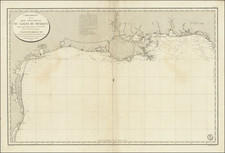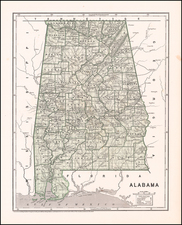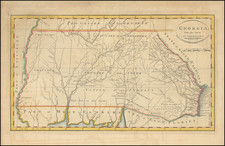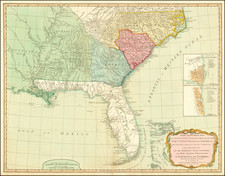The Vine & Olive Colony -- A Short-Lived Bonapartist Settlement In Alabama
Rare map of a portion of Alabama, depicting the region given to a group of French Immigrants, following the fall of Napoleon Bonaparte in France.
To encourage white settlement, land was given to many groups. One of the most unique was a group of French immigrants who wanted to establish an agricultural community to grow grapes and olives, the "Vine and Olive Colony."
The General Land Office's manuscript Map of four townships in Marengo County, Alabama: granted to the french [sic] immigrants by act of Congress 3rd March 1817 is the only known map of that gift, for which this copy from the American State Papers is the only printed version of the map.
The Vine and Olive Colony
The Vine and Olive Colony was an effort by a group of French Bonapartists who, after the fall of Napoleon Bonaparte and the Bourbon Restoration, attempted to establish an agricultural settlement growing wine grapes and olive trees in the Alabama wilderness. The area that they settled later became Marengo and Hale Counties In Alabama.
The Colony was started by the French Emigrant Association, made up of high-ranking officials and followers of Napoleon fearing for their lives after the restoration of Louis XVIII to the French throne. In the Fall of 1816 the group, headed by the former General Charles Lallemand, decided to petition Washington, D.C. for four townships in Alabama.
They began scouting the western frontiers of the Southern United States for an appropriate place upon which to establish their endeavor, selecting a location at the confluence of the Black Warrior and Tombigbee Rivers. Congress agreed to allow the settlement and on March 3, 1817, approved an act that granted them four contiguous townships of land for the price of $2 per acre on the condition that they cultivate grapes and olives. The agricultural condition was included because of concerns that several other Bonapartist colonies in the world were thought to be little more than military operations with the intention of returning Napoleon to power.
The colonists first arrived in Philadelphia, Pennsylvania, where the largest group of settlers chartered the schooner McDonough, to sail to Mobile, Alabama. They arrived in Mobile in late May 1817 and began the ascent up the rivers, arriving at their destination of Ecor Blanc, on the Tombigbee River by 14 July, 1817.
Most prominent and wealthiest among the immigrants was Count Charles Lefebvre Desnouettes, who had been a cavalry officer with the rank of Lieutenant-General under Napoleon. He was to serve as the leader of the colony. Other prominent settlers included Lieutenant-General Baron Henri-Dominique Lallemand, brother of Charles, Count Bertrand Clausel, Joseph Lakanal, Simon Chaudron, Benoît Chassériau, Pasqual Luciani, Colonel Jean-Jerome Cluis, Jean-Marie Chapron, Colonel Nicholas Raoul, and Frederic Ravesies.
The colonists, comprising about 200 people, soon established the town of Demopolis, or "City of the People", on top of White Bluff, but following a survey in August 1818, they learned that their actual land grants began less than a mile to the east of their newly cleared land. After abandoning the settlement of Demopolis, they soon established two other towns, Aigleville and Arcola. Aigleville was named in honor of Napoleon's ensign, featuring an eagle. Arcola was named for the Battle of the Bridge of Arcole, site of a Napoleonic victory in 1796. Arcola became the largest town in the colony.
The colonists soon discovered that their land was not suited for the growth of Grapes and Olives necessary to fulfill the condition placed by Congress on their grants. The colony sent a representative, Charles Villar, to Washington to plead their case. Congress modified the grant by supplementary act on April 26, 1822, allowing the settlers to retain their land in the event that growing grapes and olives proved fruitless.
The colony had few laborers, faced a constant encroachment on their territory by American squatters, and experienced floods and droughts, which led to the eventual collapse of the colony. After 1825, most of the settlers left the colony to return to France or settle in Mobile or New Orleans, Louisiana, although a few did stay on their grants permanently.
Rarity
The map is rare. This is the second example, we have seen on the market.










![[ Tennessee / Louisiana / Mississippi / Alabama ] Boston Mountains (408) Radar AAF Aeronautical Chart](https://storage.googleapis.com/raremaps/img/small/97161.jpg)
![[ French Louisiana ] Carte De la Louisiane par Le Sr. D'Anville Dressee en Mai 1732. Publiee en 1752](https://storage.googleapis.com/raremaps/img/small/88804.jpg)


